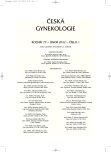Genetic factors in etiology of uterine fibroids
Authors:
K. Kubínová; M. Mára; P. Horák; D. Kužel
Authors‘ workplace:
Gynekologicko-porodnická klinika VFN a 1. LF UK, Praha, přednosta prof. MUDr. A. Martan, DrSc.
Published in:
Ceska Gynekol 2012; 77(1): 58-60
Category:
Original Article
Overview
Uterine fibroids are the most common pelvic tumors in women of reproductive age. The cause of development of uterine fibroids is still unknown, however recent cytogenetic and genetic studies led to advancement in understanding of etiology of these tumors. In accordance with the latest findings up to 40% of uterine fibroids bear some chromosomal abnormalities. The most common are aberration of chromosomes 6, 7, 12 and 14. Uterine fibroids have been linked to mutations of fumarate hydratase (FH) gene. Germline mutations in FH gene cause autosomal dominant syndromes MCUL1 (multiple cutaneous and uterine leiomyomata) and HLRCC (hereditary leiomyomatosis and renal cell cancer), characterized by multiple uterine and cutaneous leiomyomata and renal cancer. This paper reviews recent findings in the role of genetic in etiology of uterine fibroids.
Key words:
uterine fibroid, cytogenetic, chromosomal aberration.
Sources
1. Barker, KT., Spendlove, HE., Banu, NS., et al. No evidence for epigenetic inactivation of fumarate hydratase in leiomyomas and leiomyosarcomas. Cancer Letters, 2006, 235, 1, p. 136-140.
2. Cramer, SF. The frequency of uterine leiomyomas. Amer J Clin Pathol, 1990, 94, p. 435-438.
3. Goedken, J., Rock JA. Uterine fibroids: Epidemiology and overview. In Tulandi, T. Uterine fibroids: Embolization and other treatments. Cambridge: Cambridge University press. 2003. 147 p.
4. Hennig, Y., Deichert, U., Bonk, U., et al. Chromosomal translocations affecting 12q14-15 but not deletions of the long arm of chromosome 7 associated with a growth advantage of uterine smooth muscle cells. Molecular Hum Reprod, 1999, 5, p. 1150-1154.
5. Hodge, J., Morton, CC. Genetic heterogeneity among uterine leiomyomata: insights into malignant progression. Hum Molecular Genet, 2007, 16, p. R7-13.
6. Hodge, J., Park, PJ., Dreyfuss, JM., et al. Identifying the molecular signature of the interstitial deletion 7q subgroup of uterine leiomyomata using a paired analysis. Genes, Chromosomes & Cancer. 2009, 48, 10, p. 865-885.
7. Holub, Z., et al. Management děložních myomů: CSGE doporučení k provádění správné klinické praxe. Čes Gynek, 2005, 70, s. 165-167.
8. Kiuru, M., Lehtonen, R., Arola, J., et. al. Few FH mutations in sporadic counterparts of tumor types observed in hereditary leiomyomatosis and renal cell cancer families. Cancer Res, 2002, 62, p. 16.
9. Kubínová, K. Perspektivy radiologické léčby myomů. In Mára, M. Děložní myomy: Moderní diagnostika a léčba. Praha: Grada Publishing. 2009. 231 s.
10. Launonen, V., Vierimaa, O., Kuiru, M., et al. Inherited susceptibility to uterine leiomyomas and renal cell cancer. Proceedings of the National Academy of Sciences of the United States of America. 2001, 98, s. 3387-92
11. Lehtonen, R., Kiuru, M., Vanharanta, S., et al. Biallelic inactivation of fumarate hydratase (FH) occurs in nonsyndromic uterine leiomyomas but is rare in other tumors. Amer J Pathol, 2004, 164, p. 17-22.
12. Ligon, AH., Morton, CC. Leiomyomata: heritability and cytogenetic studies. Hum Reprod Update, 2001, 7, p. 8-14.
13. Mára, M. Indikace k embolizaci myomů. In MÁRA, M. Děložní myomy: moderní diagnostika a léčba. Praha: Grada Publishing. 2009. 231 s.
14. Mark, J., Havel, G., Grepp, C., et al. Chromosomal patterns in human benign uterine leiomyomas. Cancer Genet Cytogenet, 1990, 44, 1, p. 1-13.
15. Meloni, AM., Surti, U., Contento, AM., et al. Uterine leiomyomas: cytogenetic and histologic profile. Obstet Gynec, 1992, 80, p. 209-217.
16. Okolo, S. Incidence, aetiology and epidemiology of uterine fibroids. BailliŹre, 2008, 22, 4, p. 571-588.
17. Ozisik, YY., Meloni, AM., Stephenson, CF., et al. Chromosome abnormalities in breast fibroadenomas. Cancer Genet Cytogenet, 1994, 77, 2, p. 125-128.
18. Ozisik, YY., Meloni, AM., Altungoz, O., et al. Translocation (6;10)(p21;q22) in uterine leiomyomas. Cancer Genet Cytogenet, 1995, 79, 2, p. 136-138.
19. Parker, W. Etiology, symptomatology, and diagnosis of uterine myomas. Fertil Steril, 2007, 87, p. 725-736.
20. Reeves, R. Molecular biology of HMGA proteins: hubs of nuclear function. Gene, 2001, 277, p. 63-81.
21. Rein, MS., Powell, WL., Walters, FC., et al. Cytogenetic abnormalities in uterine myomas are associated with myoma size. Molecular Hum Reprod, 1998, 4, 1, p. 83-86.
22. Tomlinson, IP., Alam, NA., Rowan, AJ., et al. Germline mutations in FH predispose to dominantly inherited uterine fibroids, skin leiomyomata and papillary renal cell cancer. Nature Genet, 2002, 30, p. 406-410.
23. Xing, YP., Powell, WL., Morton, CC. The del(7q) subgroup in uterine leiomyomata : genetic and biologic characteristics. Further evidence for the secondary nature of cytogenetic abnormalities in the pathobiology of uterine leiomyomata. Cancer Genet Cytogenet, 1997, 98, p. 69-74.
Labels
Paediatric gynaecology Gynaecology and obstetrics Reproduction medicineArticle was published in
Czech Gynaecology

2012 Issue 1
Most read in this issue
- Is the hysteroscopy the right choice for therapy of placental remnants?
- To conclude knowledge about new colposcopic signs – ridge sign and inner border.
- Risk factors for recurrent disease in borderline ovarian tumors
- The psychosocial needs of newborn children in the context of perinatal care
